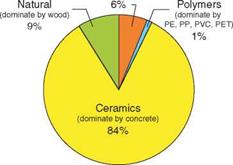Materials. Speaking globally, we consume roughly 10 billion (1010) tonnes of engineering materials per year, an average of 1.5 tonnes per person, though it is not distributed like that. Figure 2.1 gives a perspective: it is a bar chart showing consumption of the materials used in the greatest
|
|
||
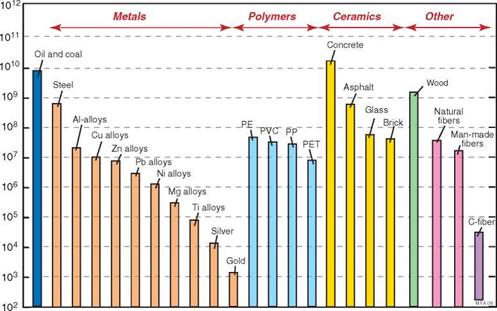
|
FIGURE 2.2
quantities. The chart has some interesting messages. On the extreme left, for calibration, are hydrocarbon fuels—oil and coal—of which we currently consume a colossal 9 billion (9 X 109) tonnes per year. Next, moving to the right, are metals. The scale is logarithmic, making it appear that the consumption of steel (the first metal) is only a little greater than that of aluminum (the next); in reality, the consumption of steel exceeds, by a factor of 10, that of all other metals combined. Steel may lack the high-tech image that attaches to materials like titanium, carbon-fiber enforced composites, and (most recently) nanomaterials, but make no mistake, its versatility, strength, toughness, low cost, and wide availability are unmatched.
Polymers come next. Fifty years ago their consumption was tiny; today the consumption of the commodity polymers polyethylene (PE), polyvinyl chloride (PVC), polypropylene (PP), and polyethylene-terephthalate (PET) exceeds that of any metal except steel. The really big ones, though, are the materials of the construction industry. Steel is one of these, but the consumption of wood for construction purposes exceeds even that of steel, even measured in tonnes per year (as in Figure 2.1), and since it is a factor of 10 lighter, if measured in m3/year, wood totally eclipses steel. Bigger still is the consumption of concrete, which exceeds that of all other materials combined. The other big ones are asphalt (roads) and glass. The last column of all illustrates things to come: it shows today’s consumption of carbon fiber. Just 20 years ago this material would not have crept onto the bottom of this chart. Today its consumption is approaching that of titanium and is growing much more quickly.
Figure 2.2 presents some of this information in another way, as a pie chart showing the tonnage-fraction of each family of material: metals, polymers,
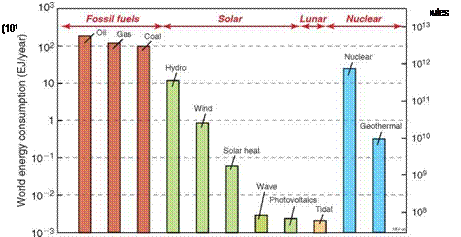
ceramics, and natural. The logarithmic scale of Figure 2.1 can be deceptive; the true magnitude of the consumption of concrete only emerges when plotted in this second way. This is important when we come to consider the impact of materials on the environment, since impact scales with the quantity consumed.
Energy. Although this book is about materials, energy appears throughout; it is inseparable from the making of materials, their manufacture, their use, and their disposal. The SI unit of energy is the joule (J), but because it is very small, we generally use kJ (103 J), MJ (106 J), or GJ (109 J) as the unit. Power is joules/sec, or watts (W), but it too is small, so we usually end up with kW, MW, or GW The everyday unit of energy is the kWhr, one kW drawn for 3600 seconds, so 1 kWhr = 3.6 MJ.
Where does energy come from? There are really only four sources:
■ The sun, which drives the winds, wave, hydro, photochemical, and photoelectric phenomena
■ The moon, which drives the tides
■ Nuclear decay of unstable elements inherited from the creation of the Earth, providing geothermal heat and nuclear power
■ Hydrocarbon fuels, the sun’s energy in fossilized form
All, ultimately, are finite, but the time scale for the exhaustion of the first three is so large that it is safe to regard them as infinite.
How much energy do we use? Energy is measured in joules, but when we speak of world consumption the unit is the exajoule, symbol EJ, a billion
|
|
|
(a) |
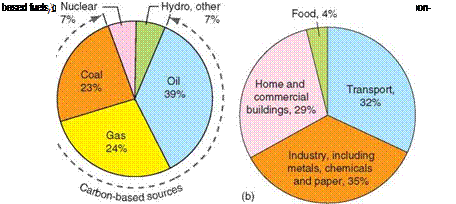
billion (1018) joules. The value today (2008) is about 500 EJ, and, of course, it is rising. It comes from the sources shown in Figure 2.3. Fossil fuels dominate the picture, providing about 86% of the total (Figure 2.4a). Nuclear gives about 7%. Hydro, wind, wave, solar heat, and photovoltaics add up to just another 7%. These sun-driven energy pools are enormous, but unlike fossil and nuclear fuels, which are concentrated, they are distributed. The problem is that of harvesting the energy, something we return to in later chapters.
Where does the energy go? Most of it goes into three big sectors: transportation, buildings (heating, cooling, lighting), and industry, including the production of materials (Figure 2.4b).
Figures 2.3 and 2.4 focus on the sources of energy. To be useful you have to do something with energy, and that, almost always, involves energy conversion. Figure 2.5 suggests the possible conversion paths, not all of them practical perhaps, but there in principle. Almost always, conversion carries energy "losses." Energy, the first law of thermodynamics tells us, is conserved, so it can’t really be lost. What happens is that in almost all energy conversion, some energy is converted to heat. High-grade heat is heat at high temperature, as in the burning gas of a power station or the burning fuel of the combustion chamber of an IC engine or gas turbine; it can be used to do work. Low-grade heat is heat at low temperature, and for reasons we get to in a moment, it is not nearly so useful; indeed, most of it is simply allowed to escape, and in this sense it is "lost." Energy conversion generally has low-grade heat as a by-product. The exception is the conversion electrical to thermal energy; it has an efficiency n of 100%, meaning that all
FIGURE 2.5
the iR energy dissipated by the electrical current ends up as heat. But that is where it ends. The refining of metals from their oxide, sulfide, or other ores, for instance, involves the conversion of thermal or electrical energy into chemical energy—the energy that could (in principle) be recovered by allowing the metal to reoxidize or resulfidize. The recovered energy, of course, is a lot less than the energy it took to do the refining; the conversion efficiency is low.
The conversion efficiencies of the many paths in Figure 2.5 differ greatly even when "ideal," meaning that the conversion is as good as the laws of physics allow. Conversion of thermal to mechanical energy, for instance, is ultimately limited by the Carnot efficiency, n c:
T
![]()
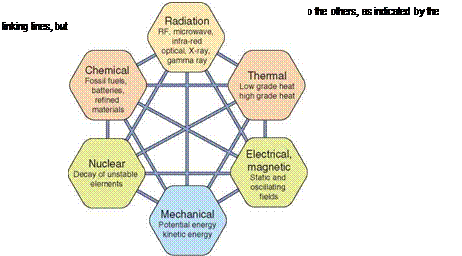
l _ ±out
in
where Tin is the temperature of the steam or hot gas entering the heat engine and Tout is the temperature at which it exits. Plotted, this looks like Figure 2.6. The maximum input temperature Tin is limited by the materials of the turbine blades and discs (around 650°C for steam turbines, as much as 1400°C for gas turbines) and by the exhaust temperature Tout (at least 150°C), giving a theoretical maximum efficiency of about 75%.
The real conversion efficiencies of heat engines are much less than this. Steam engines of the early 19th century had efficiencies of perhaps 2%. The
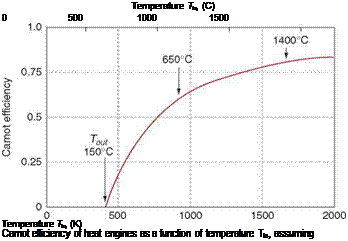 |
FIGURE 2.6
Tout = 150°C.
first electricity-generating plant built in Holborn, London, in 1882 had an efficiency of just 6%. A modern steam-turbine plant today achieves 38%, although the national average in a country like the United States or the United Kingdom is less than this (around 35%, a value we use later). A plant driven by a gas turbine can reach 50%, a consequence of a higher Tin and lower Tout. Table 2.1 lists practical efficiencies of other energy conversion processes. Many are low. Thus a more useful measure of efficiency n is simply the ratio:
Power out n =
Power in
where Power is energy, in any form, per unit time. This is the definition used in the rest of the book.
Using energy to extract and refine materials is an example of an energy conversion process. The energy per unit mass consumed in making a material from its ores and feedstock is known as its embodied energy. The term is a little misleading; only part of this energy is really "embodied" in the sense that you could get it back. That bit is the free energy difference between the refined material and the ore from which it came. Take a metal—say, iron—as an example. Iron is made by the reduction of the oxide hematite, Fe2O3, in a blast furnace. Thermodynamics dictates that the minimum energy needed to do this is 6.1 MJ/kg; it is the free energy of oxidation of iron to this particular oxide. This energy could, in principle, be recovered by reoxidizing the
|
Table 2.1 Some approximate efficiency factors for energy conversion |
|||
|
Energy conversion path |
Efficiency, direct conversion (%) |
Efficiency relative to oil equivalence (%) |
Associated carbon (kg CO2 per useful MJ) |
|
Fossil fuel to thermal, enclosed system |
100 |
100 |
0.07 |
|
Fossil fuel to thermal, vented system |
65-75 |
70 |
0.10 |
|
Fossil fuel to electric |
33-39 |
35 |
0.20 |
|
Fossil fuel to mechanical, steam turbine |
28-42 |
40 |
0.17 |
|
Fossil fuel to mechanical, gas turbine |
46-50 |
48 |
0.15 |
|
Electric to thermal |
100 |
35 |
0.20 |
|
Electric to mechanical, electric motors |
85-93 |
31 |
0.23 |
|
Electric to chemical, lead-acid battery |
80-85 |
29 |
0.24 |
|
Electric to chemical, advanced battery |
85-90 |
31 |
0.23 |
|
Electric to em radiation, incandescent lamp |
15-20 |
6 |
1.17 |
|
Electric to em radiation, LED |
80-85 |
30 |
0.23 |
|
Light to electric, solar cell |
10-20 |
— |
0 |
iron under controlled conditions (it is truly "embodied"). But the measured energy to make iron—the quantity that is called its embodied energy—is three times larger, at about 18 MJ/kg, a conversion efficiency of 33%. Where has the rest gone? Mostly as heat lost in the gases of the blast furnace. Similar losses reduce the efficiency of all material synthesis and refining.
Water. Manufacture draws on another resource, that of water. Water is a renewable resource, but renewable only at the rate that the ecosystem allows. Increasing demand is now putting supply under growing pressure: the worldwide demand for water has tripled over the past 50 years. Forecasts suggest that water might soon become as important an issue as oil is today, with more than half of humanity short of water by 2050. Agriculture is the largest consumer worldwide, taking about 65% of all fresh water, but in industrialized countries it is industry that is the big user.
The water demands of materials and manufacture are measured directly as factory inputs and outputs. The unit used here is liters of water per kg of material produced, l/kg (or, equivalently, kg/kg, since a liter of water weighs 1 kg). The range for engineering materials extends from 10 l/kg to over 1000 l/kg. What is water used for? In the production of steel, as an example, water is used in the extraction of the minerals (iron ore, limestone, and
|
FIGURE 2.7
fossil fuels), for material conditioning (dust suppression), pollution control (scrubbers to clean up waste gases), and cooling material and equipment.
We ignore saltwater usage. Seawater is extremely abundant, making up 97% of the water on Earth. Accessible fresh water accounts for less than 1%; the remainder is fresh water locked up as ice in glaciers and icecaps (see Figure 2.7). The water consumption for the growth of natural materials requires a distinction between those that are irrigated and those that are not. Plant life that is the source of materials such as wood, bamboo, cork, and paper is not, as a general rule, irrigated, whereas plants used in the production of some thermoplastics (cellulose polymers, polyhydroxyalkano – ates, polylactides, starch-based thermoplastics) and for cattle feedstock (for leather) generally require irrigation. For this reason it is usual to split water usage into two parts: commercial water usage and total water usage. For most materials these two values are the same, but whereas the total water usage in the growing of trees and plants includes nonirrigation water, the commercial water usage is just that used for irrigation. The data in the data sheets in Chapter 12 of this book are for commercial water usage.
The provision of energy, too, uses water for cooling cycles (with loss by evaporation) and for dust suppression and washing. Table 2.2 lists water usage per MJ of delivered energy for electricity, both produced and distributed via a public grid system, and electricity produced industrially. (Industrial electricity generation is more efficient because the hot gases produced can be used in other processes, whereas they are simply vented in electricity production for the grid.)

